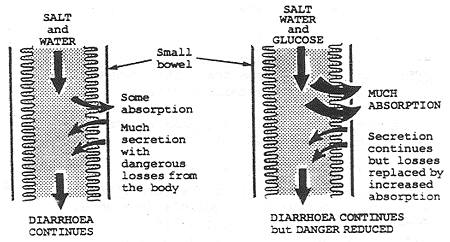Slide 9
How oral rehydration works This slide shows the chemicals which you can use to make the most
scientific kind of oral fluid. You need sodium chloride (which is ordinary
kitchen salt),
sodium bicarbonate (which is baking soda), potassium chloride and
glucose.
They are called 'Oral Rehydration Salts' or 'ORS' or (even though glucose is a
sugar, and not a salt). When you dissolve them in the right amount of water, you
make ORS solution, which is one kind of oral rehydration fluid.
The blue half of the slide lists how much of each chemical to put into one litre
of
water. The other half of the slide shows two packets of a kind of ORS called
"ORALYTE"*. One packet contains all the chemicals in the blue list.
* The word "ORALYTE" is made from the two words "ORAL and
"ElectroLYTE". When the salts are dissolved in water, they are called
"Electrolytes".
UNICEF (The United Nations Children's Fund) and WHO (The World Health
Organization) promote and distribute 'Oralyte', but there are other brands which
very similar.
Many people have tested ORS solution, and they have found it very good for
treating diarrhoea. (Reference
4).
Q. Why do you need all those chemicals? Is that the only way to make oral
fluids?
A. The next few slides explain why these chemicals are useful. If the diarrhoea
is severe, they are very useful. But 'oral fluids' is only a medical way of
saying 'a drink'. Sometimes health workers who know about ORS joke that
they need some 'oral fluids' when they feel thirsty at tea time: If you don't
have ORS or those chemicals, you can still give a child (or that thirsty health
worker) his 'oral fluids'. A drink of sweet tea, or even
plain water is good if diarrhoea has just started. We say more about this in
Slides="diarrhoea-management-15.htm" target="_blank">15 -18.
Q. Which chemical does a packet of ORALYTE contain the largest amount of?
A. Glucose. Notice the weight of glucose is larger than all the other three.
Teacher's Note
Switch off the projector, and ask your audience
to write down the formula of ORS from memory. Vary this exercise according to
their experience and level of training. For some workers, you need only ask the
names of the chemicals. Others might be able to remember the quantities also.
Make sure that they also remember the quantity of water. If you are kind, you
will warn your audience before you switch off the slide that you are going to
ask them to remember it! |
Figure 3 - Replacement of Fluids by Mouth in Active
Diarrhoea
